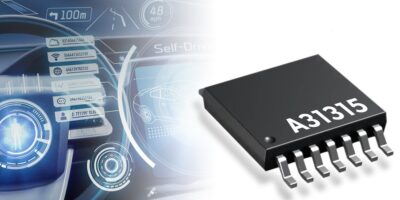Magnetic position sensor meets ASIL-D for ADAS applications
The latest addition to the 3DMAG family of rotary and linear magnetic position sensor ICs for automotive and industrial applications has been announced by Allegro Microsystems. The A31315 sensor delivers the accuracy and performance needed to meet stringent ASIL-D requirements of safety-critical automotive applications, says the company.
Allegro’s 3DMAG sensors combine its planar and vertical Hall-effect technologies to measure magnetic field components along three axes (X, Y, Z). This enables true 3D sensing capabilities with a wide magnetic dynamic range without saturation, says Allegro.
The A31315 sensor is claimed to address the functional safety challenges posed by advances in advanced driver assistance systems (ADAS) and autonomous driving systems, by delivering the measurement accuracy necessary to meet the stringent requirements of safety-critical steering, braking, transmission and throttle systems.
The sensors’ flexible 3D Hall-effect front end and configurable signal processing architecture enable highly accurate, absolute linear position and rotary position measurements up to 360 degree. Existing Allegro 3DMAG devices, such as the ALS31300 and ALS31313 sensors, also support 3D magnetometer applications in which all three magnetic components (BX, BY, BZ) are required to track complex magnetic movements.
The A31315 is a highly accurate A31315 position sensor, says Allegro. It contains advanced on-chip diagnostic features to ensure reliable, safe operation and supports both rotary and linear position sensing with native angle error over temperature in any plane (less than 1.2 degrees over the operating temperature range). Following Safety Element out of Context (SEooC) functional safety guidelines, the A31315 supports ASIL-B (single die) and ASIL-D (dual die) system level integration in accordance with ISO 26262. It is also automotive-qualified to AEC-Q100 Grade 0.
The A31315 sensor is available as a single die in a compact SOIC-8 package, and as a fully redundant stacked dual die in a TSSOP-14 package for applications requiring redundancy or higher levels of measurement. Allegro says its stacked die construction closely aligns the sensing elements of both die, ensuring the measurement of nearly identical magnetic fields. This design enables the dual-die A31315 sensor to offer superior channel matching performance and tighter channel comparison thresholds common in fully redundant safety systems.
The 3DMAG sensors have a wide range of programmable channel trim and linearisation options which can be adjusted to the magnetic circuitry to optimise the sensors for accuracy and manufacturing efficiency in end-of-line programming times for specific applications. The sensors also offer low power consumption and flexible power management options, enabling battery life optimisation in portable applications, says Allegro.
The 3DMAG sensors support flexible low-voltage programming through sensor outputs regardless of the interface (e.g. analogue, SAE J2716 SENT, PWM, I2C), allowing direct programming by a microcontroller in embedded designs and simplifying the interface for end-of-line system calibration. This low-voltage programming option also opens up new system architectures with remote field-replaceable sensor module designs that can be programmed by the electronic control unit (ECU).




